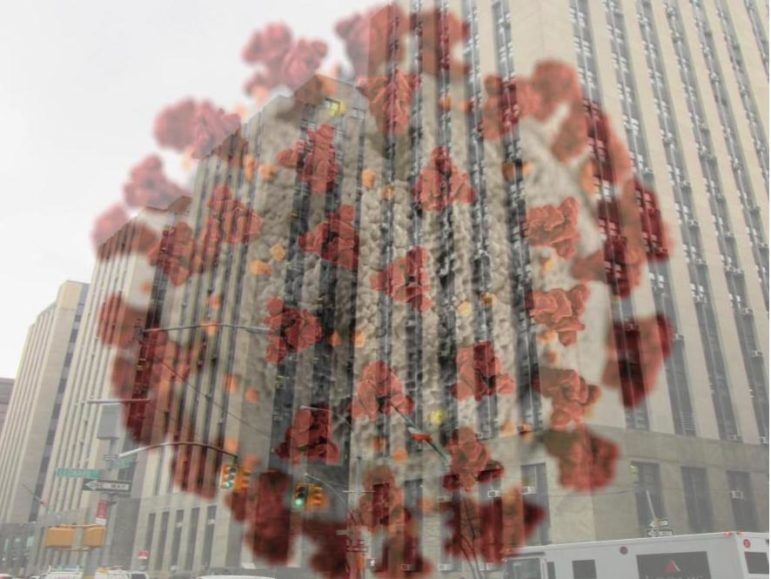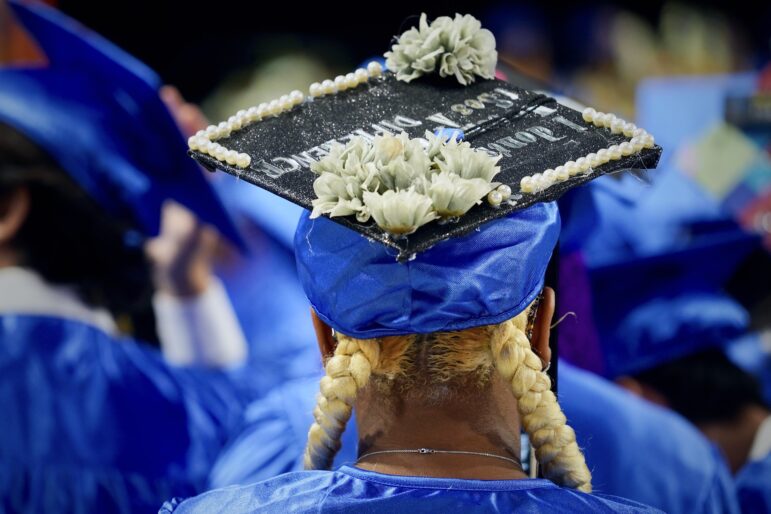
Beyond My Ken/CDC
COVID and the Manhattan criminal courthouse on Centre StreetThe last day I was in a courtroom was a little before 1 a.m. on March 14th, as I wrapped up a shift in Brooklyn Criminal Court night arraignments. I had no idea, as I met with clients, spoke to prosecutors and argued to the judge, that I carried COVID-19 and facilitated its spread to colleagues, clients and court staff.
I felt fine, but “fine” is usually the best I can ask for when running on the fumes of vending-machine caffeine. I had no idea that I felt rundown and had a stomachache because I had already become infected with a potentially fatal virus.
I was in court that night because a high-risk colleague needed to get out of the shift, and I am young, healthy, and have no contact with anyone high-risk. I didn’t know a single person who had tested positive or had any semblance of symptoms. I washed my hands. I avoided touching my face. I even used hand sanitizer- something I swore off in college after I learned about superbugs.
Socially distancing wasn’t an option. I, along with six other lawyers and a clerk, sat in an area that was maybe eight feet by eight feet. We passed papers and pens back and forth. My clearest memory from that night was, in a rush to fill out a form, using my mouth to uncap a pen. That night isn’t just etched in my mind because it was my last time in a courtroom, but because colleagues from that night got sick shortly after, and a few weeks later, one of them died.
About 36 hours after I walked out of that courtroom, I got a fever. It wasn’t very high but it came with body aches and a dry cough. Since it checked all of the CDC boxes at that time, except, mercifully, shortness of breath, I started telling people.
 CityViews are readers’ opinions, not those of City Limits. Add your voice today!
CityViews are readers’ opinions, not those of City Limits. Add your voice today!
I wanted to make sure everyone whom I had seen knew what was going on so they could isolate themselves, know to look out for symptoms, and prepare to be sick. I emailed my office’s COVID inbox. I called friends. I texted colleagues, adversaries, court staff, and others. Mostly they hoped I was wrong, that I just had a cold. Mostly I said I hope I’m wrong too. I didn’t know. I’m sorry. I was finally tested a few days later and received results nine days after I got the fever. The test came back positive.
I knew some of the people I was in court with that night were high-risk—some colleagues, some clients. And I knew how close together we all sat. How we shouted to be heard in the client interview booths. How we lean in close to colleagues and adversaries in order to hear one another while other cases are being discussed on the record. What I don’t know, what I can’t know is who, if anyone, I infected that night. Did I give a colleague the virus as I handed them a pen? As I laughed at a joke? I don’t know. I can’t know. I do know it’s not my fault. I didn’t know I was sick. I couldn’t have known I was contagious.
I also know that I shouldn’t have been in court that night. No one should have been. The New York State Office of Court Administration already had a plan to conduct court virtually but they waited to put it into place until the case count was higher. And that was too late for so many.
Right now, they are trying to send us back to court, which will force our vulnerable clients to face unnecessary exposure on public transportation and from court staff and other people in the building. If courts begin to approach “normal” operations they will wait in lines for temperature screens and metal detectors, take crowded elevators to high floors, and wait in courtrooms to have their cases heard on non-emergency matters.
If you’ve never been to courts in New York City, even the newest buildings are teeming with people and their germs. Just to call a single case, there have to be at least 10 people in the room. One judge. One clerk. One court reporter. Four court officers. One prosecutor. One defense attorney. One person who stands accused of a crime and possibly their family members. So when OCA tells us that it will only have 10 cases on at once, that doesn’t mean just 10 people confined to one courtroom, but many, many more, all at risk of contracting and spreading the same virus that killed so many, including my colleague.
The courts continue to be super spreader venues with poor ventilation and little room to socially distance. Even with limited calendars and staggered times, New Yorkers accused of crimes, along with their family and attorneys will wait for much longer than the CDC’s recommended fifteen-minute cutoff for close contact. When courts are operating at full capacity, they often wait for hours. There is loud talking. And close talking. And it is extremely difficult, often impossible, to know who was there on a particular day for contract tracing purposes. Re-opening the New York City courts to non-emergency, in-person appearances right now is an unnecessary mistake. It is a mistake that will have fatal consequences.
Court appearances have been happening every day through this pandemic. New Yorkers are arraigned from 9 a.m. until 1 a.m. and often later. Pleas are taken. Cases are dismissed. Preliminary hearings are being held. All via Skype. It’s not perfect. It’s hard to create trust with a client, to convince a judge or a prosecutor by yelling into my laptop, over my AC and theirs, from my kitchen. But it’s safe. Safe for clients, colleagues, adversaries, and the court staff.
It’s not worth holding in-person court just to say that it’s being done—not until it’s safe to return to court.
Martha Lineberger is a public defender for the Legal Aid Society.









6 thoughts on “Opinion: Lives Hang in the Balance as Courts Resume In-Person Work”
Absolutely correct. Doing things virtually and observing all the CDC rules is whyNY has done so well. We don’t want to back slide!
Absolutely agree. Perfect description of how COVID-19 can be shared through the in person court appearance. Happy to hear you recovered.
Thank for sharing your personal experience
I hope this article reaches the needed ears
Martha, glad to hear you are well and thank you for this writing. What will it take? Perhaps, someone collapsing? I don’t know, maybe drop dead in front of a judge to convince the courts re-opening is a huge mistake at this time. Would that convince OCA? Is high times OCA invest in state of the art technology and court rooms. The old way of wasting time in courts for hours on end has got to be eliminated!!! We cannot continue with these outdated buildings, outdated technology at OCA public stations. You often see the public struggling to figure out why they cannot access or request forms from OCA computers. When is not the computers, is the Wi-Fi. When the copiers are broken/out of paper there are no court staff personnel around to assist the public user. OCA hire more hands to clean the public filthy bathrooms on a continuous basis. Not simply just twice a day (morning & evening). Look around technology is sweeping our lives, OCA need to invest in modernizing court rooms and virtually move forward permanently. What is the need to bombard court rooms during this pandemic? OCA please reinvent lessening the time wasted in these court rooms. Come up with a better plan than just business as usual which is killing folks. Let’s begin working together to a VIRTUAL NEW WORLD if we live beyond this Coronavirus. State of the art buldings/technology is the sign of the times!!!
A lot of this woman’s complaints can be addressed. Worried that there are 10 people in courtroom? Well, aren’t they going to be wearing masks, or can’t masks be required? Can’t the court implement social distancing? Install plexiglass? Have hand-sanitizers? Crowded elevators? Can’t the officers monitor the elevators to ensure that not too many people get on them? Can’t they monitor the entrances so that, say, only 25-30 people are inside the whole courthouse at once? And the 15-minute wait before the case is called? I doubt that … the courts are doing on 10 cases per day, at set schedules. They can arrange it so that there is no wait.
See the court can address most of her concerns. Why does “No reopening whatsoever” have to be the only solution for her?
The only legit complaint that she gives in this article is that attorneys and clients would have to use public transportation. That, I can understand.
For those of you who have never been in a criminal courthouse, let me tell you that physical distancing is impossible.
Defense attorneys can’t stand 6+ feet away from a client and expect a confidential conversation about their case. Now add a mask and you can imagine how loud everyone has to speak – it’s not just about wearing masks. It’s also about ensuring the rights of the accused are preserved.
Plexiglass solves nothing. It’s like the old smoking sections of restaurants. How do you tell the expelled particulate from mouths and noses to stay behind and below the plexiglass? It’s not even a bandaid.
Friends and family come to court, taking up the space needed for physical distancing. So those seats marked off in the courtroom for defendants and witnesses are now being taken by friends and family of each. The space is decreased to an unsafe distance.
Ever wait for an elevator along with 50-100 other people? An elevator that used to carry 15 people is now only able to take 2-3. But there are still 50-100 people waiting.
Defense attorneys are being exposed to way too many people in a single day, multiplying their chances of contracting the coronavirus. The stress wears down their health and bodies defenses, making them more susceptible to error in protecting themselves. It’s literally Russian Roulette. The author may have unknowingly killed her colleague – live with that thought.
Judges sit on high, away from everyone with their special entrance and exit privileges. If you’re one of those, I can understand why you think everyone else is okay.
The courts aren’t safe. Period. You can’t trust the numbers the wardens and sheriffs are releasing to the public – they have no idea what they’re doing. They aren’t medical professionals. They’re playing a shell game with infected inmates and just throwing numbers out to quell the public interest; and by public, the only ones who really care are the attorneys and family members.
So unless you are a criminal defense lawyer or somebody who works in a criminal courtroom below the bench, you have no idea about the risks we all take on a daily basis and how those risks are not preventable during this pandemic.
While they don’t have a specific location identified yet for their Queens site, Nanda says they’re looking, and aim to occupy a privately-owned property–as their Brooklyn and Bronx locations do–as opposed to leasing or sharing space in a public school building.